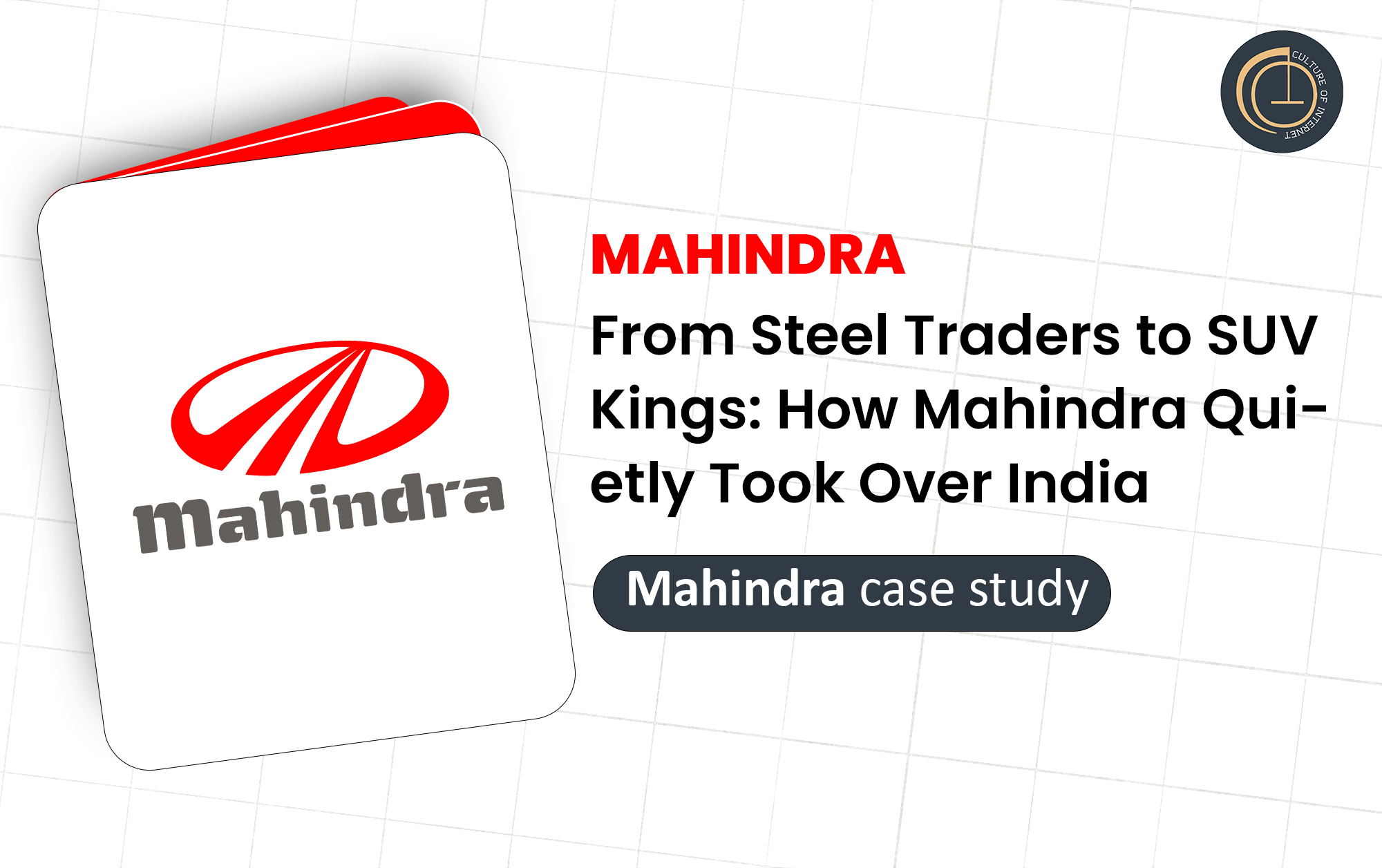Mahindra: Company Overview
Understanding the foundation and market position of the luxury automotive market worldwide.
From Steel Traders to SUV Kings: How Mahindra Quietly Took Over India
You know those brands that feel so woven into your daily life that you kinda forget they’re massive companies? That’s Mahindra for most Indians — and honestly, for a lot of folks outside India too. Whether it’s seeing a rugged Bolero hauling sugarcane in a dusty field, a Scorpio overtaking you on a highway like it owns the road, or spotting one of their tractors parked under a banyan tree on a hot afternoon — Mahindra’s everywhere. But behind those chunky, tough-looking vehicles and quiet brand presence is a story so wild, gutsy, and heartwarming, it could easily be a Bollywood biopic.
Let’s unpack it properly — no buzzwords, no AI tone. Just how it happened.
It Started with Steel, Sweat, and a Partition
So picture this — India in 1945. The country’s still under British rule. The air’s thick with rebellion and the slow burn of freedom movements. Two brothers, Jagdish Chandra Mahindra and Kailash Chandra Mahindra, along with a third partner, Ghulam Muhammad, start a humble steel trading business in Ludhiana, Punjab. Nothing fancy — no grand opening, no flashy logos. Just three men trying to make a living in a country waiting to break free.
The firm was called Mahindra & Muhammad. They sold steel, imported hardware, and basically hustled like every other Indian businessman back then. But history had other plans. In 1947, India got its long-awaited independence — and with it, the horrors of Partition. Ghulam Muhammad chose to move to the newly formed Pakistan, where he eventually became their finance minister. The Mahindra brothers, however, stayed put.
They renamed the business Mahindra & Mahindra, and in a bold, slightly crazy move, decided to pivot into something nobody else was really doing yet — assembling Willys Jeeps in India for the military. Yep, those iconic army vehicles you see in old war films? Mahindra started bringing them in, putting them together, and sending them off to the frontlines.
From steel pipes to combat-ready jeeps — classic desi hustle.
Where’s Mahindra Standing Today?
Fast forward to 2024, and Mahindra isn’t just a company anymore — it’s a full-blown ecosystem. They’ve spread their roots so deep and wide that you’ll find a Mahindra something-or-other no matter where you go. Rural India? You’ll see their tractors tilling fields. Indian cities? XUV700s and Thars zipping past. The US? Mahindra tractors are a common sight in Texas. Tech parks in Pune and Bangalore? Tech Mahindra logos gleaming on glass towers.
It’s insane how much they’ve diversified:
- →SUVs and passenger vehicles
- →World’s largest-selling tractors
- →Tech Mahindra in IT and digital solutions
- →Electric vehicles and mobility startups
- →Defense, aerospace, real estate, and financial services
- →Hospitality ventures like Club Mahindra
From Ludhiana to global domination, with over 260,000 employees across 100+ countries. Not bad for a company that started with steel trading.
What Makes Mahindra… Mahindra?
The thing with Mahindra is — they’ve never tried to be flashy for the sake of it. Their vehicles aren’t about Italian leather seats or digital cockpits with mood lighting. They’re about getting the job done, whether it’s carrying sacks of grain through a river or climbing a mountain trail in Himachal.
Their biggest USP isn’t just their product range; it’s the desi spirit they carry. Mahindra’s always had one foot firmly planted in rural India and another reaching for the skies. They’ve bet on SUVs when India barely had highways and invested in electric vehicles long before anyone even talked about green mobility here.
They’re not afraid to take risks, and even when something flops, they wear those scars with pride. Unlike most big corporates obsessed with quarterly results, Mahindra takes the long view. They build for farmers, city kids, software engineers, and road-trippers alike. It’s personal for them.
Mahindra’s Life Story in Fast-Forward
A quick timeline, because this one’s fun:
Steel
Steel trading as Mahindra & Muhammad
Partition
Renamed Mahindra & Mahindra after Partition
Jeeps
Starts assembling Willys Jeeps in India
Tractor
Enters tractor manufacturing; soon dominates the market
Launch
Launches Scorpio, India’s first proper homegrown SUV .
Tech
Jumps into IT with Tech Mahindra
Korea
Buys Korea’s SsangYong Motor Company
Give
New Thar, XUV700, Scorpio-N, electric vehicles, global expansion
Plenty of wins, a few flops, and a whole lot of guts.
Big Wins & Bragging Rights
Mahindra might not scream about their achievements, but their record is seriously impressive:
- →World’s largest-selling tractor company by volume
- →First Indian company to win the Deming Prize for quality in Japan
- →Tech Mahindra is now one of India’s top 5 IT firms
- →Their Scorpio rewrote the SUV rulebook in India in 2002
- →First Indian automaker to enter the US market with tractors
And fun fact: Mahindra sells a tractor somewhere in the world every two minutes. That’s 30 tractors an hour, 720 a day. Mind-blowing.
Mahindra by the Numbers (2024)
You can’t talk business without the numbers, so here’s how Mahindra’s stacked up recently:
| Business Segment | 2024 Revenue | Market Position |
|---|---|---|
| SUVs & Cars | ₹80,000 Crores | #2 in India for SUVs |
| Tractors | ₹28,000 Crores | #1 Globally |
| Tech Mahindra | ₹56,000 Crores | Top 5 IT Firm |
| Financial Services | ₹9,000 Crores | Leading NBFC |
Their XUV700 and Scorpio-N are backlogged on bookings, their electric 3-wheelers are quietly killing it in Tier 2 towns, and their farm equipment division’s expanding into Africa and the US.
The Mahindra Network — It’s Huge
Think of Mahindra not as a company, but as a network of ecosystems. There’s Mahindra dealerships in the tiniest towns in India. Tractor assembly plants in the US Midwest. Tech Mahindra campuses in Dallas, Pune, and London. Aerospace facilities making parts for Airbus and Boeing.
Over 3,000 dealerships and touchpoints in India alone. Mahindra Adventure off-roading events. Mahindra Racing in Formula E. They’ve got finance services reaching deep into rural India where regular banks won’t go. It’s not a business, it’s a web of interconnected communities. That’s their power.
How Mahindra Built Their Empire
The secret sauce? They don’t sit still. Mahindra’s never been content with one market:
-
Entered the US tractor market in the 90s and cracked Texas
-
Bought SsangYong to crack the Korean SUV space (mixed results though)
-
Partnered with Renault for Logan (a dud) but gained priceless car-making experience
-
Invested early in electric mobility and Reva Electric
-
Pushed into defense and aerospace manufacturing
They’re willing to try new things, fall flat sometimes, and get right back up. That’s rare in a risk-averse corporate world.
Smart Partnerships (Good, Bad & Ugly)
Not every collab worked, but Mahindra’s learned from each:
-
Renault Logan — a boxy sedan that flopped but taught them global car design
-
Ford JV — gave Mahindra critical SUV engineering chops.
-
Reva Electric — scooped up EV tech before the rest of India cared
-
Dewulf tie-up — improved their farm machinery game
Even the bad deals left them smarter, tougher, and sharper.
The Messy Bits — What Went Wrong
It wasn’t all smooth roads:
-
SsangYong became a financial headache
-
Delays in EV production saw Tata steal the early lead
-
Chip shortages during COVID slowed down vehicle deliveries
-
SUV wars with Hyundai, Tata, and Kia have been brutal
But true to their character, Mahindra didn’t make excuses. They doubled down on what they do best — building cars for the real India.
How Mahindra Bounced Back
Their comeback’s been textbook. New designs, bold marketing, a fresh SUV logo, and a digital-first strategy turned things around:
-
New Thar — absolute cult status
-
XUV700 — waitlists stretching months
-
Scorpio-N — instant blockbuster
-
Strong focus on electric commercial vehicles and last-mile mobility
They adapted without losing their desi DNA.
The Process of Becoming Big
It wasn’t overnight. Mahindra’s rise was built on:
-
Understanding India — urban and rural
-
Taking bold bets when others wouldn’t
-
Building relationships, not just transactions
-
Constant reinvention
They combined old-school values with new-school agility.
Mahindra’s Digital Game Is Strong
Gone are the days of dusty showrooms. Mahindra’s digital pivot is impressive:
-
Viral launch teasers
-
Influencer off-roading events
-
YouTube vlogs and behind-the-scenes factory tours
-
Online car booking, loans, and service apps
-
WhatsApp for customer care
Old dog. New tricks. And they’re killing it.
SWOT Snapshot
They know what they’re about.
Strengths
Iconic brand, SUV muscle, rural loyalty
Weaknesses
A few bad global bets
Opportunities
EV boom, AI-driven agriculture, financial tech
Threats
SUV market wars, geopolitical issues
Keep the Lambo Feeling
Even with better tech and smoother driving, they never lost their loud engines, wild designs, and aggressive road presence.
What’s Coming Next?
Expect Mahindra to double down on:
-
Electric SUVs
-
Smart farming gear
-
Mobility-as-a-service projects
-
Clean energy businesses
-
And knowing them, maybe even resorts on Mars someday.
Final Thoughts
Mahindra’s story isn’t some spotless success tale. It’s messy, ambitious, heartbreakingly desi, and impossible not to respect. From steel traders in Ludhiana to a global empire, they’ve shown that real businesses don’t follow maps — they make their own roads.
And man, what a road it’s been.
Explore Our Comprehensive Marketing Strategy Course
Join our in-depth course to master Mahindra India's marketing strategies, learn from expert case studies, and gain actionable insights to apply in your own business or career.









